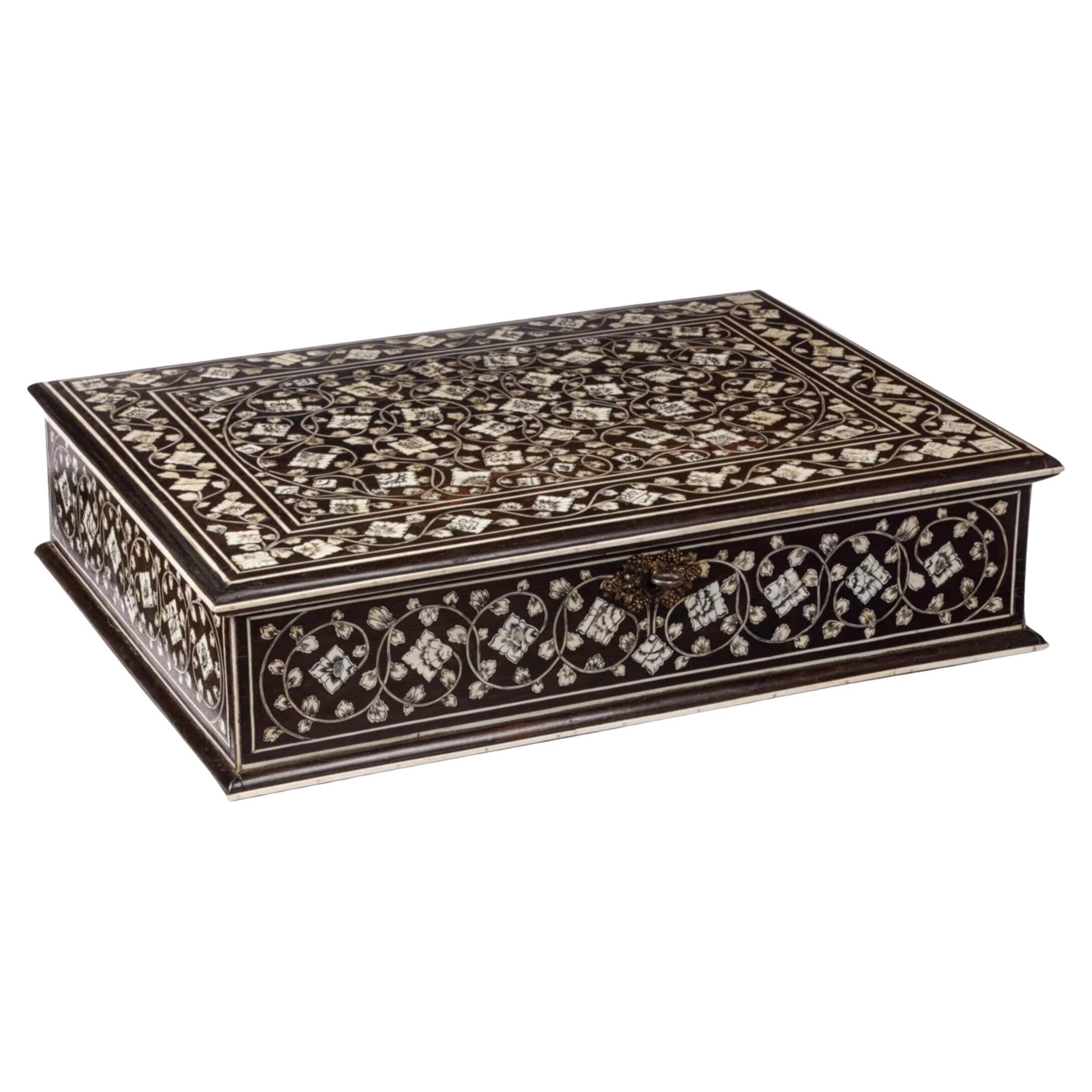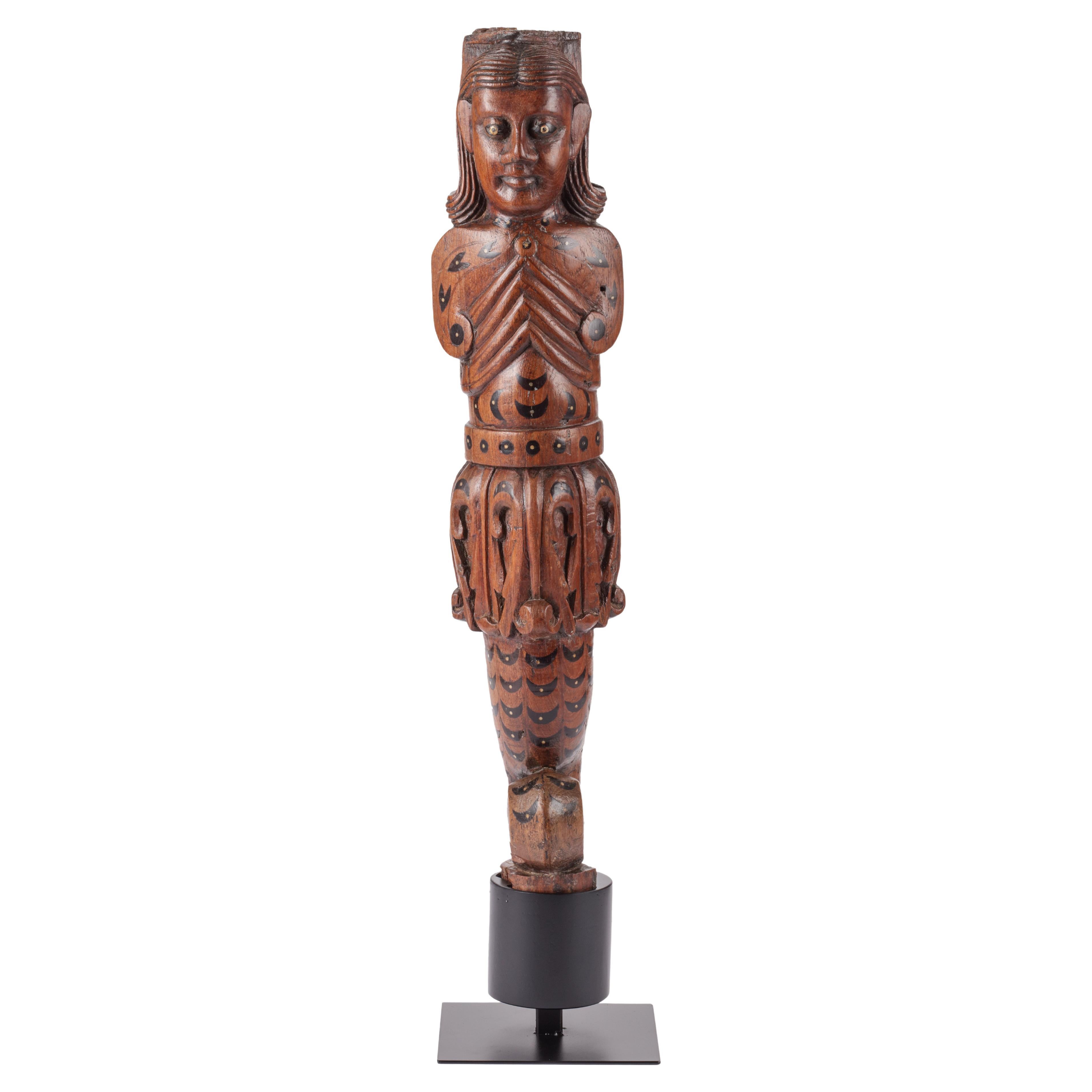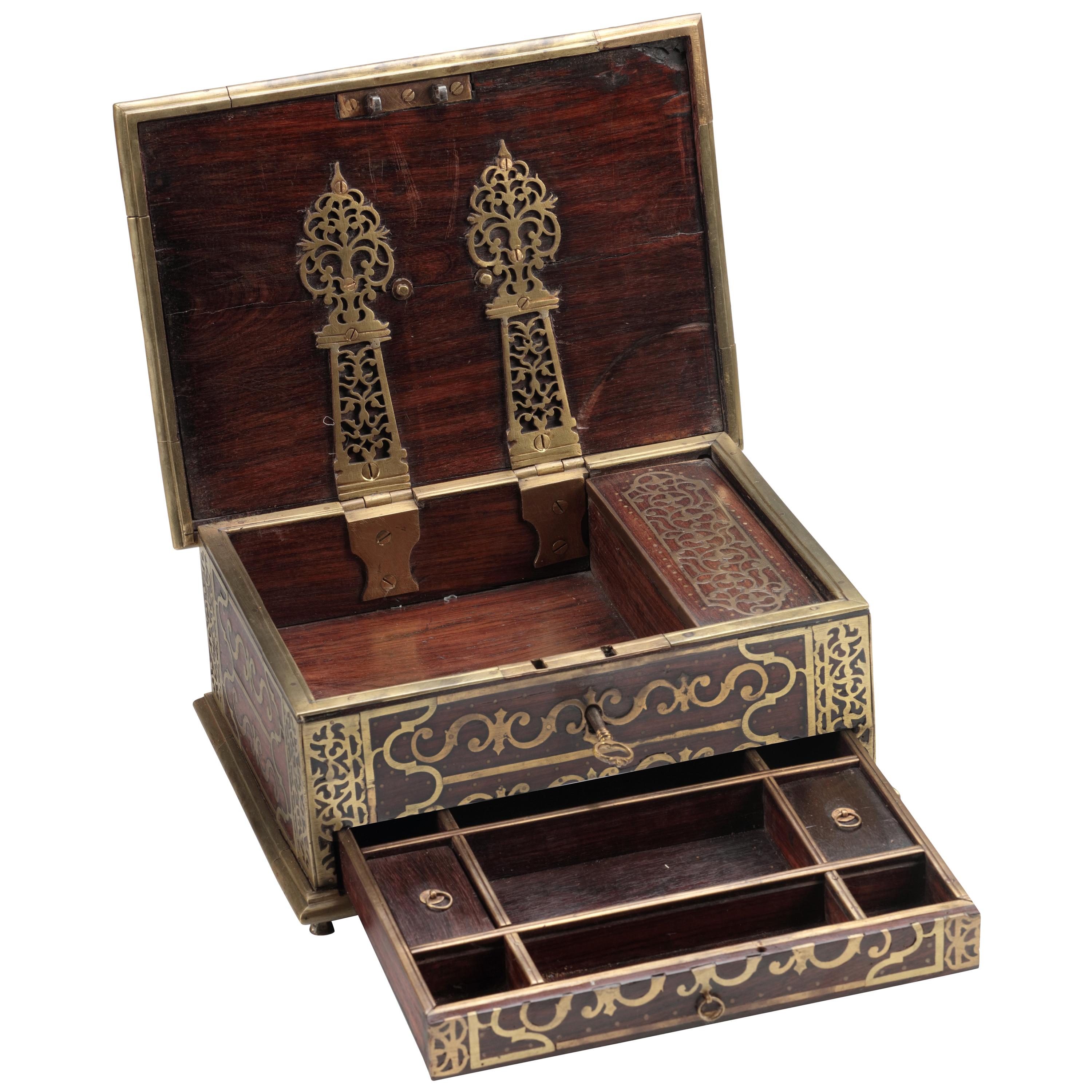Items Similar to 17th century colonial Sinhalese ebony two-door cabinet with silver mounts
Want more images or videos?
Request additional images or videos from the seller
1 of 12
17th century colonial Sinhalese ebony two-door cabinet with silver mounts
About the Item
A splendid Dutch-colonial Sinhalese ebony two-door cabinet with silver mounts
Sri Lanka, Kandy, 2nd half 17th century, the mounts later
The cabinet with a central drawer with hidden compartment and the top drawer divided into four compartments. The surface carved all-over with scrolling plants issuing fleshy lotus palmettes, and in addition the exterior of the doors with a pair of kinnaris, the top with a seated deity encircled by birds, the back with a central lotus rosette flanked by quadrupeds and birds, and lastly the sides with a serapendiya, bordered by narrow diaper kundi rakkan bands.
H. 29 x W. 32.5 x D. 23 cm
The richly decorated panels carved in differing degrees of relief reveal the skill of the Sinhalese craftsmen and the scrolls issuing a richness of flowers and fruits are indicative of the island’s vegetal abundance. Their stylization is result of a cross-fertilization of Dutch and Sinhalese decorative elements that appear on furniture, textiles and silver that later appeared across the Asian VOC territories. The mythical kinnaris, serapendiya and the kundi rakkan banding are typical forms of Sinhalese ornamentation, but not often seen on furniture for the Dutch. (Mediaeval Sinhalese Art, Ananda K. Coomaraswamy, Pantheon Books 1908).
For cabinets of similar form and decoration see: Furniture from Indonesia, Sri Lanka and India during the Dutch period, Jan Veenendaal, 1985 pl.25, 29 and 58. Comparable Sinhalese furniture and objects with related carved decoration can be found in the Royal Collection Trust (21610, 21611), the Museum of Fine Arts Boston (1993.29) and the British Museum (1943.0712.4).
Provenance:
Private collection, United Kingdom
Peter Lang, United Kingdom
- Dimensions:Height: 11.42 in (29 cm)Width: 12.8 in (32.5 cm)Depth: 9.06 in (23 cm)
- Style:Dutch Colonial (Of the Period)
- Materials and Techniques:
- Place of Origin:
- Period:
- Date of Manufacture:circa 1650-1690
- Condition:Wear consistent with age and use.
- Seller Location:Amsterdam, NL
- Reference Number:1stDibs: LU5458233746752
About the Seller
5.0
Vetted Seller
These experienced sellers undergo a comprehensive evaluation by our team of in-house experts.
Established in 1985
1stDibs seller since 2020
19 sales on 1stDibs
Typical response time: 3 hours
- ShippingRetrieving quote...Ships From: Amsterdam, Netherlands
- Return PolicyThis item cannot be returned.
More From This SellerView All
- A 17th century Dutch-colonial ebony two-door VOC cabinet with silver mountsLocated in Amsterdam, NLA Dutch-colonial ebony two-door cabinet with silver mounts Coromandel Coast, probably Masulipatnam, circa 1650-1680, the silver later H. 64.5 x W. 75 x D. 46 cm The present cabinet...Category
Antique 17th Century Indian Dutch Colonial Antiquities
MaterialsSilver
- 18th century Dutch-Colonial ‘Vizagapatam’ pen-engraved bone inlaid ebony boxLocated in Amsterdam, NLA large Indian Colonial ‘Vizagapatam’ pen-engraved bone inlaid ebony box Masulipatnam or Vizagapatam, 2nd half 18th century H. 10.8 x W. 47 x D. 34 cm ...Category
Antique Late 18th Century Indian Dutch Colonial More Asian Art, Objects ...
MaterialsBone, Ebony
- Splendid Indo-Portuguese Colonial Sculpture of Nagini from Goa, 17th CenturyLocated in Amsterdam, NLA fine Indo-Portuguese inlaid teak wood figure of Nagini India, Goa, 17th century Measure: H. 55 cm (with stand, and with ring for wall hanging) The sculpture can be perceived as such but probably is one of four legs of an Indo-Portuguese contador...Category
Antique 17th Century Indian Jewelry Boxes
MaterialsEbony, Teak
- 16th-Century Indo-Portuguese Colonial Mother-of-pearl Gujarat CasketLocated in Amsterdam, NLAn exceptional Indo-Portuguese colonial mother-of-pearl veneered casket with silver mounts India, Gujarat, 2nd half of the 16th century, the silver mounts Goa or probably Lisbon Measures: H. 16 x W. 24.6 x D. 16.1 cm An exceptional Gujarati casket with a rectangular box and truncated pyramidal lid (with slopes on each side and a flat top) made from exotic wood, probably teak (Tectona grandis), covered with a mother-of-pearl mosaic. The tesserae, cut from the shell of the green turban sea snail (Turbo marmoratus, a marine gastropod) in the shape of fish scales, are pinned to the wooden structure with silver ball-headed nails. The casket is set on bracket feet on the corners. The masterfully engraved decoration of the silver mounts follows the most refined and erudite Mannerist repertoire of rinceaux and ferroneries dating from the mid-16th century. The high quality and refinement of the silver mounts and, likewise, the silver nails that replaced the original brass pins used to hold the mother-of-pearl tesserae in place indicate the work of a silversmith probably working in Lisbon in the second half of the 16th century. The Indian origin of this production, namely from Cambay (Khambhat) and Surat in the present state of Gujarat in north India, is, as for the last three decades, consensual and fully demonstrated, not only by documentary and literary evidence - such as descriptions, travelogues and contemporary archival documentation - but also by the survival in situ of 16th-century wooden structures covered in mother-of-pearl tesserae. A fine example is a canopy decorating the tomb (dargah) of the Sufi saint, Sheik Salim Chisti (1478-1572) in Fatehpur Sikri in Agra district in the state of Uttar Pradesh, north India. This is an artistic production, geometric in character and Islamic in nature, where usually the mother-of-pearl tesserae form complex designs of fish scales or, similar to the dishes also made using the same technique, with the thin brass sheets and pins, stylized lotus flowers. The truncated pyramidal shape corresponds, like their contemporary tortoiseshell counterparts also made in Gujarat, to a piece of furniture used in the Indian subcontinent within the Islamic world prior to the arrival of the first Portuguese. This shape, in fact, is very old and peculiar to East-Asian caskets, chests or boxes used to contain and protect Buddhist texts, the sutras. A similar chest is the famous and large reliquary chest from Lisbon cathedral that once contained the relics of the city's patron saint, Saint Vincent. Both match in shape, having the same kind of socle or pedestal and bracket feet, and in their engraved silver mountings, featuring the same type of refined, erudite decoration. Their differences lie in the silver borders that frame the entire length of the edges of the chest (both the box and the lid), pinned with silver nails, and on the lock plate, shaped like a coat of arms in the Lisbon example. Given the exceptional dimensions of the reliquary casket...Category
Antique 16th Century Indian Jewelry Boxes
MaterialsSilver
- Colonial Islamic Arabian Market Jewelry Box, 18th Century, India/Malabar CoastLocated in Amsterdam, NLAN INDIAN ROSEWOOD AND EBONY BRASS MOUNTED BOX FOR THE ISLAMIC MARKET Malabar Coast, 18th century With a large drawer with several compartments under a lid with two com...Category
Antique 18th Century Indian Islamic Jewelry Boxes
MaterialsBrass
- Ebony Veneered Captain's Chest or Strong Box 'Coffre Fort', 17th CenturyLocated in Amsterdam, NLA strongbox was a type of travelling chest and these types of boxes were more common in England than anywhere else where they were fabricated between 1660 and 1720. The earliest proo...Category
Antique Late 17th Century Dutch Dutch Colonial Decorative Boxes
MaterialsBrass
You May Also Like
- 17th Century Silver Mounted Traveling Box with KeyLocated in Dallas, TXA 17th century silver mounted Coromandel wood with mother of pearl inlay traveling box with a Interior fitted with drawers and a reliquary cabinet. W...Category
Antique 17th Century French Decorative Boxes
MaterialsSilver
- Chinese Elmwood Early 20th Century Makeup Chest with Doors and DrawersLocated in Yonkers, NYA Chinese elmwood makeup or jewelry chest from the early 20th century with five drawers and brass hardware. Created in China during the early years of the 20th century, this small el...Category
Early 20th Century Chinese Decorative Boxes
MaterialsBrass
- 17th-18th Century Spanish Colonial Box With Domed TopLocated in Dallas, TXSpanish Colonial inlaid bone and faux tortoiseshell domed top box. Original hammered iron hinges. Circa 1680-1740. Excellent condition and very rare.Category
Antique 1690s Spanish Decorative Boxes
MaterialsIron
- Indian 19th Century Round Silver Plated Metal Box with Pierced Foliage MotifsLocated in Yonkers, NYAn Indian silver plated metal box from the 19th century with pierced foliage motifs. Created in India during the 19th century, this silver plated metal box attracts our attention wit...Category
Antique 19th Century Indian Decorative Boxes
MaterialsSilver Plate, Copper
- Japanese Tabako-bon with Two Rabbits, c. 1920Located in Chicago, ILThis wooden box is a Japanese tabako-bon, or 'tobacco tray,' used to store tobacco and smoking accessories. Believed to have evolved from the traditional ...Category
Early 20th Century Japanese Taisho Snuff Boxes and Tobacco Boxes
MaterialsBamboo, Bakelite, Hardwood
- Anglo-Indian Footed Box with Lidded Compartments, 19th CenturyLocated in North Hollywood, CA19th century Anglo-Indian wooden box fitted with various compartments finely hand carved. The top is finely hand carved with the Taj Mahal. The interior with removable hand carved nine-lidded compartments, the front cover has a mirror, the whole exhibiting very fine workmanship. This fine late Victorian Anglo-Indian box from India is in great condition for it age. A beautiful example of an Anglo-Indian fine art...Category
Antique Late 19th Century Indian Anglo-Indian Decorative Boxes
MaterialsSandalwood
Recently Viewed
View AllMore Ways To Browse
India Decorative Arts
With Hidden Drawer
17th Century Dutch Jewelry
Perles De Corail
Vintage Mappin And Webb Handbag
Vintage Mappin And Webb Handbags
Agresti Box
Weed Holders
Boite A Bijoux Antique
Ghidini Cherry Jewelry Box
Incolay Jewelry Boxes
Marqueterie Boite
French Jewelry Box Casket
Vintage Marble Jewelry Box
Ormolu Jewel Box
Paul Mccobb Jewelry Box
Ladies Antique Dresser
Vintage Pewter Jewelry Box





